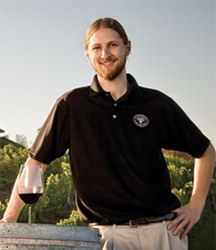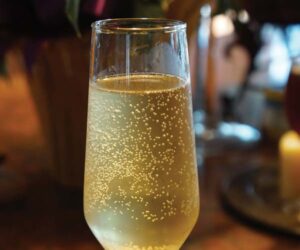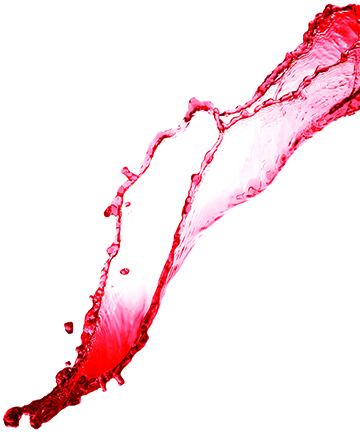
The role of oxygen has been the subject of considerable controversy in the attempts of scientists to explain the complex process of the aging of wine. The great Émile Peynaud, a highly influential Professor of Enology at the University of Bordeaux in the second half of the 20th century, has been many times quoted that “oxygen is the enemy of wine.” What Dr. Peynaud really contended was that the problem was misunderstood from the beginning because of a basic confusion, reflected in the opposing views that “oxygen makes the wine” and “oxygen is the enemy of wine.”
In truth, then as now, few winemakers understood what he was talking about. Wine historian Harry Paul likens the situation to the wave/particle debate in physics. “However, no Bohr appeared in oenology with a theory of complementarity to explain that a single model might not be adequate to explain the observed phenomena. The fact is that the assertions apply to different types of wine and their different modes of aging.” It’s an odd coincidence that this individual should emerge from Peynaud’s very birthplace, the tiny hamlet of Madiran in southwest France.
In 1997, I found myself in a bar in Reno, Nevada, sharing a beer with a young gentleman by the name of Thierry Lemaire, freshly arrived for the American Society for Enology and Viticulture (ASEV) conference. Thierry wanted my wine technology company, Vinovation, to take on a new process his boss, Patrick Ducournau, had recently invented by the name of microbüllage, or micro-oxygenation. His ridiculous claims included that it increases body, stabilizes color, refines texture, controls sulfides, eliminates protein fining and the use of copper, diminishes pyrazines, oakiness, and Brett aromas, and enhances longevity. Yeah, right, and all my children will marry doctors?
I didn’t believe a word of it. Still, there was growing interest in this latest fad, so we decided to take on the distributor and set up a two-year study with a dozen wineries. I put a disclaimer on the websites saying we made no claim that any of this was true.
When the study was concluded, I took the disclaimer down. It worked exactly as Thierry claimed. What followed was years of intense instruction and experience with thousands of wines, eventually leading to the publication in 2013 of Postmodern Winemaking, my tribute to Ducournau’s genius.
I like to think of oxygenation as much like using a stove. You can definitely get burned if you don’t know what you’re doing. Yet skilled use of a stove is the essence of fine cuisine.
There are all kinds of ways of using the stove. I’ll make some distinctions here that are similar to the difference between slow cooking and searing. Where you use a slow cooker to soften and tenderize a cheap pot roast cut, you sear a ribeye steak at high temperature to bring out the flavor.
Same with oxygen. Sometimes we’re trying to refine the texture, add body, and extend longevity; other times we’re trying to bring forward the aroma to display fruit and promote early release.
Enological oxygenation in its various forms presents challenges for small-scale winemaking. These combined with the need to learn a sophisticated skill set means that taking on these practices will require careful attention, initial investment, and courage not so different from learning to cook. Some things like boiling an egg will be simple, others like poaching quenelles are trickier to learn.
While oxygen is now used by commercial winemakers throughout the world, education is lacking and the term is used to refer to practices that really are not micro-oxygenation (MOx) at all.
Accordingly, I want to begin with a discussion of terminology, distinguishing six ways to utilize oxygen beneficially in wine, seen the following graphic:
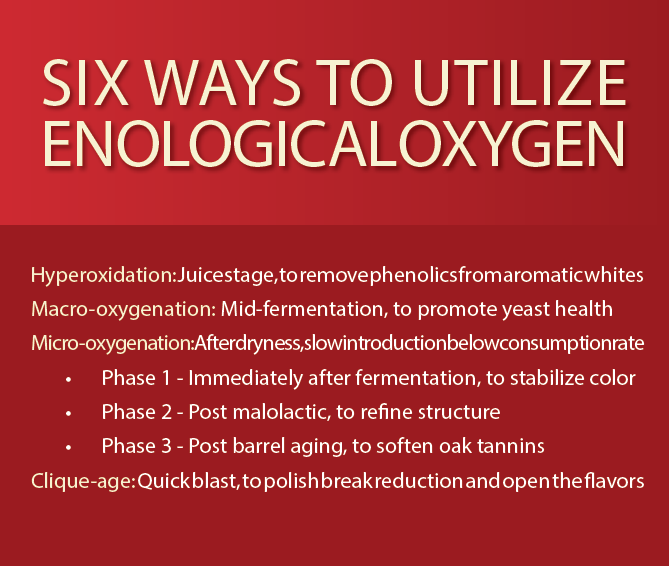
Once we have that sorted out, I’m going to describe the six methodologies in more detail.
When we get to micro-oxygenation, I’ll clarify terms the French use for different types of tannin mouthfeel (Figure 1, later).
Next, I’ll talk about what goals you might set for a particular wine. Then I will explain the equipment you need (and what you should avoid) and run you through some practical tips to implement these six methodologies on a small scale.
You will note in the sidebar, below, that the first method is an “oxidation.” We are actually oxidizing the phenolics, though not the juice, due to the extremely rapid enzymatic action. All the other treatments are “oxygenations,” which do not oxidize the wine.
Ways wine benefits from oxygen
Now let’s look at each closer.
Hyperoxidation: Here we’re bringing a saturation or even three saturations of oxygen to the juice of an aromatic white or sparkling cuvée prior to fermentation.
Now, why in the world would we want to do that? Well, the white “aromatic” varieties we’re talking about have a lot of terpenes in them. Muscat, Malvasia, Riesling, Gewürztraminer, and Viognier grapes are quite delicious eating on the vine. These terpenes make them very popular with birds and bees, leading to a lot of damage to the fruit. And so, just like a banana or an apple, these varieties have developed a lot of tannin to cauterize the wounds brought about by these predators.
Unfortunately, those phenolics are going to polymerize later on in the wine and cause it to brown. Hydrogen peroxide is generated as a byproduct of that polymerization, which attacks terpenes, destroying freshness and oxidizing them to TDN (1,1,6-Trimethyl-1,2-dihydronaphthalene), which smells like petrol.
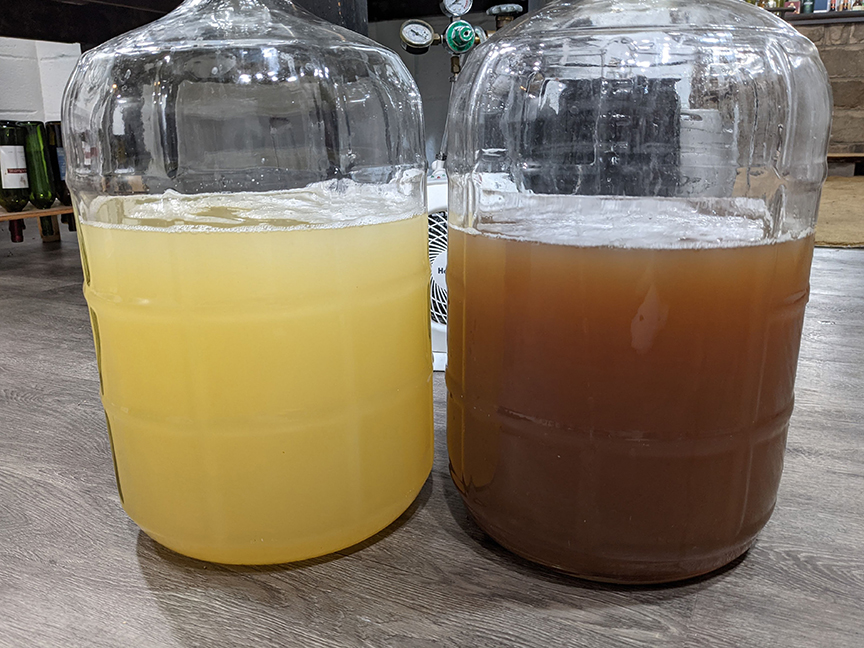
The solution, very popular in the Mosel, is to introduce oxygen to the fresh juice prior to any SO2 addition, causing rapid browning by the enzyme polyphenol oxidase, which can consume an entire saturation to disappear in 45 minutes. It’s common to add two additional saturations 45 minutes apart, after which protein is added to promote overnight settling.
Although initially gelatin was used, English pea protein preparations are now on the market that work better. BSG’s Agrovin and Lamothe-Abiet’s Greenfine Must are good examples.
Instead of waiting for settling, a more common practice for winemakers is to employ flotation by air injection, and then returning in the morning to rack the clarified juice from under the compact floating cap that resembles chocolate pudding.
Sulfur dioxide (around 30 ppm) may then be added if desired prior to inoculation. Exposure to oxygen should be prevented post-fermentation to maintain freshness. Believe it or not, a lighter, fresher wine with considerable shelf life will result.
Because of their high acidity, sparkling wine producers go to great lengths to minimize tannins in their cuvées, often employing light pressing and low yields, losing as much as 40 gallons per ton (1 L per 6 kg). A large fraction can be reclaimed through hyperoxidation.
Macro-oxygenation is the injection of oxygen at mid-fermentation to raise the redox potential. Highly reduced conditions in the must can cause sluggish or stuck fermentations. A saturation of oxygen can promote yeast health and dryness. It is often accompanied by nutrient additions specifically designed for the process such as Fermaid O from Scott Labs.
Yeasts in active fermentation gobble up oxygen with incredible enthusiasm — perhaps a thousand times as much as phenolic reactivity. Some winemakers perform aerative rackings on highly tannic musts in the vain hope to evolve wine structure, but this really can’t occur until fermentation is complete.
The day of dryness, we enter the world of oxygenative structuring. By definition, micro-oxygenation feeds the wine oxygen at a rate less than its ability to react it up. Its goals have much in common with (and indeed may be considered a branch of) French cuisine.
In 1825, Brillat-Savarin transformed French cuisine in his classic work, Physiology of Taste. The fundamental nature of la cuisine ever after focuses on the skillful creation of soulful structure, be it in a béarnaise sauce or a soufflé. Its essence is distilled in the dual meanings of finesse: The first meaning grace and refinement, as in English, but the second infers “fineness,” i.e. small particle size. Thus, a bisque is more soulful if the tiny butter beads suspended in it are very small.
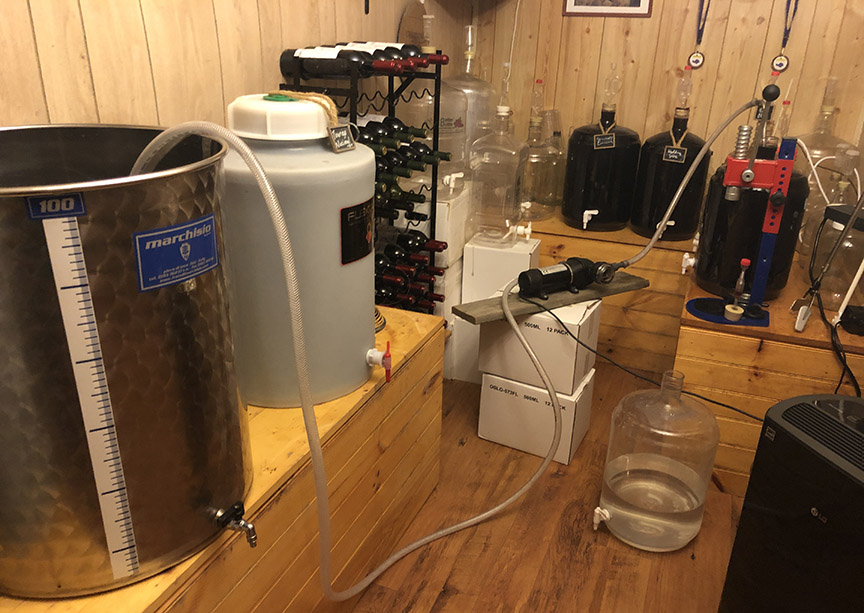
Transforming grape extractives into wines of fine structure is the goal of micro-oxygenation and related techniques such as exposure to oak and lees. Our goal is to create very small colloidal structures whose large combined surface area leads to refined texture, aromatic integration, soulful resonance, and graceful longevity.
If you hang around Masters of Wine, you’ll hear the term “structure” employed in another (and I think erroneous) way, to mean the interplay of sugar, acid, alcohol, and other constituents of the wine’s sensory impressions as they occur in the brain’s sensory appreciation. This so-called “structure” is not in the wine and is better referred to as “balance.”
Contrary to common belief, micro-oxygenation is not designed as a way to accelerate aging. You can accelerate aging with it, but that’s not really what it’s for. We can do some much more wonderful things if we use it in a skillful manner. To say that a micro-ox unit is a way to accelerate aging and get into the bottle quicker is like saying that your Porsche is a really good flashlight. And it is a really good flashlight — but that’s not really what it’s for. A Porsche’s true purpose is high-performance driving. And micro-ox is really about high-performance winemaking, or as the French call it, “élevage.”
The result is homeopathic. The structures MOx creates are more reactive with the untreated wine. As we proceed, particularly in Phase 1, the wine’s appetite increases and we find ourselves increasing the dosing rate. As a result, release dates are pushed off into the future.
Red wine’s appetite for oxygen varies more than a thousand-fold over its lifetime. We measure this reactivity in mLs (or sometimes mg) of oxygen per liter of wine per month. (1.00 mL of oxygen weighs 1.42 mg.) Since a barrel imparts about 1 mL/L/mo., we sometimes call these “barrel equivalents,” or BEs.
The main mechanism of oxidative polymerization known as the vicinal diphenol cascade was worked out by Vern Singleton at UC-Davis in 1987 and involves a second-order double reaction, making it highly temperature-dependent. Ducournau’s team determined empirically that phenolic structuring can only be accomplished within a strict and narrow temperature zone between 59–65 °F (15–18 °C). Below this temperature, reactivity slows precipitously, while above the zone, oxidative reactions are energetically favored to the wine’s detriment.
Within micro-oxygenation, we identify three phases. Phase 1 commences just after dryness, prior to any malolactic (ML) and SO2 addition, usually lasting two to four weeks. Its primary objective is to stabilize color. The wine has a great deal of oxygen appetite at this point. Even a light red such as Pinot Noir will consume about 20 BEs, with Merlots and Cabernet Francs taking up 40–50 BEs, California Cabernet Sauvignon at 60–80, and heavyweight Petite Sirah and Tannat sometimes devouring over 100 BEs.
Things happen fast. It pays to monitor tannin status two or three times a week as the wine progresses from green, to hard, to firm, to round, to melted. Armchair enologists may find this annoying, but my view is that being forced into regular personal conversations with a wine in its first month of life, a continual back-and-forth about what the wine can be and wants to be, is one of the strongest reasons to take on MOx. As Woody Allen put it, “80% of life is just showing up.”
We want the wine to be somewhat aromatically closed and not building dissolved oxygen (DO). Mastery of sensory assessment is the best way to steer the wine’s development during this critical period. Successful use of enological oxygen requires hands-on monitoring of tannin evolution, for which the winemaker needs training in a set of sensory distinctions.
Figure 1 depicts the terminology we translated from common French oenological terms for different tannin sensations (more precisely, astringencies resulting from the interaction of different tannin structures with salivary protein). These are literal translations, some of which I dislike, but which we employ to easily correspond to their French counterparts, since very little discussion of tannin sensory types occurs in English-speaking universities.
FIGURE 1:
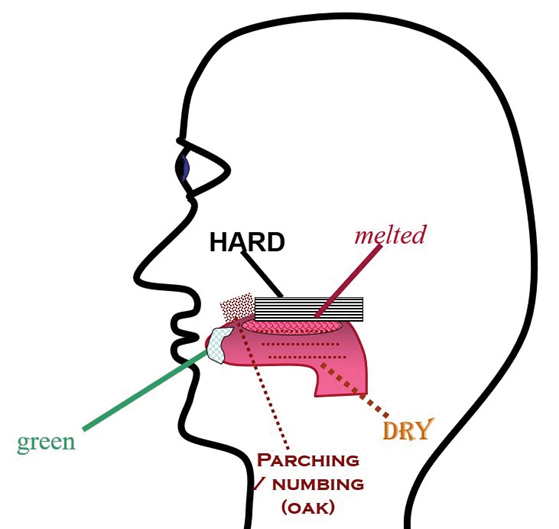
An exception is the Australian work of Richard Gawel, Anita Oberholster, and Leigh Francis on a 56-descriptor Mouthfeel Wheel, which we applaud while finding it a bit cumbersome for practical oxygenation work. We did, however, import their term “parching/numbing” for oak tannin. The presence of the numbing effect of the topical anesthetic eugenol that oak contains makes it relatively easy to distinguish from the grape-derived tannin sensations. The following discussion applies principally to red wine tannins.
Green tannin (tanin verte) is the tannin found in all red wine immediately upon the conclusion of alcoholic fermentation on skins. It occurs entirely on the tip of the tongue and is grainy in nature — probably it’s the copigmentation colloids composed of monomeric phenolics and anthocyanins. Despite its name, it does not indicate under-ripeness nor vegetal flavors, so I would prefer to call it “raw tannin” were not the French term so firmly entrenched.
If such a wine is completely deprived of oxygen in youth, this graininess will spread throughout the mouth, coating the cheeks and the entire surface of the tongue and eventually will precipitate out after a few years in barrel or bottle. This we call dry tannin (tanin sec). It’s the only type of astringency that can be found on the bottom of the tongue. Home winemakers who press wines into neutral stainless or glass carboys under a blanket of inert gas will experience their wines drying out and falling apart, especially if their color is low.
If a young wine is given a discreet dose of oxygen, the grainy green tannin is replaced within a few days with hard tannin (tannin dur), which loses its graininess and is no longer present on the tip of the tongue. It seems to leap up on top of the tongue, now with a sheet-like grippiness that adheres to the roof of the mouth like peanut butter. It’s sometimes call “octopus tannin” because of its grip.
After passing through this phase, the grip will subside to firm tannin (tanin firme) and then will begin to soften from the back of the palate, converting to melted tannin (tanin fondue). When a wine is melted in back but still grippy on the front half of the tongue, this is round tannin (tannin ronde), a stage where many winemakers barrel down reserve wines to allow further resolution in barrel and in bottle. Wines for early release may be fully melted prior to bottling, particularly if screwcap closures are to be employed.
If a wine is showing excessive aldehyde or fruitiness, we turn the rate down. If the fruit is too closed or sulfides are present, we turn it up. This is called “surfing the aldehyde.” As Thierry says, “No need to dance faster than the music.”
Phase 1 is the best time to add oak alternatives containing tannin. Post-ML, only de-tanninized alternatives are recommended. If the wine is destined for new oak barrels, it is common practice to allow the ML to take place in the new barrels to soften the oak tannins, after which the wine is returned to tank for SO2 addition and Phase 2 treatment if desired.
Phase 2 takes place after ML is complete and SO2 is added. The purpose of Phase 2 is to refine texture, integrate pyrazines, quench sulfides and soften new oak tannins. Phase 2 work happens at a lower rate. Far from protecting the wine from oxidation, SO2 in red wine actually drops the Phase 1 rate by a factor of 12 by reversing the vicinal diphenol cascade elucidated by Singleton 92% of the time. If a Cabernet Sauvignon was taking 60 BEs in Phase 1, it can be expected to take 5 BEs in phase 2.
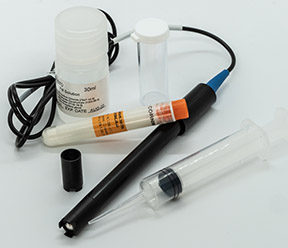
Changes occur more slowly in Phase 2, and one need only check the wine once every week or two. A typical run lasts two or three months, after which the wine is generally barreled down. Alternatively, it may be kept in neutral vessels such as Flextanks with oxygen porosity on one barrel equivalent with the addition of oak alternatives as desired.
Generally the time in barrels will resolve wine tannins and lower the wine’s appetite to around 1 BE, at which time it should be removed from barrel and bottled. Unfortunately, by this time the wine frequently has penetrated the stave and begun to extract increasing amounts of parching/numbing tannin. This cannot be resolved in barrels unless they are quite old.
The solution is to come back to tank and harmonize the wine with very low amounts of oxygen — a tannin haircut, if you will. This is Phase 3. It will proceed at 0.25–1 BEs and generally takes about two months.
Finally we have clique-age. Clique-age is a short pulse of oxygen — the French call it “violent” oxygen — just a few seconds where we’re blasting in 1–2 ppm. Its purpose is to open the wine up and to speed its development along, rather the opposite of micro-oxygenation, which can increase the wine’s reductive strength and actually push its release date off. Here, we’re opening the wine up.
So we’re talking about a barrel treatment that’s similar to aerative racking except it’s a lot more convenient if you have a large number of barrels. We drop a diffuser into the barrel and use a handheld remote to trigger a solenoid that determines the dose. The solenoid opens up a valve allowing the oxygen to flow until the timer turns it off after 30 seconds or so. Since these gadgets were originally developed in France, the French solenoid says “clique,” and that’s where the term “clique-age” comes from.
It’s often accompanied by an SO2 addition with a fizzy tablet to add 5–10 ppm. Plop, plop, fizz, fizz.
Bringing It All Back Home
Hyperoxidation on a small scale is simple to perform. As with all enological techniques, pure oxygen is recommended over air. The 78% nitrogen in air keeps the bubbles large so the oxygen they contain doesn’t dissolve readily. Injection into a sintered stainless stone or other fine diffuser is recommended. Dissolved oxygen is at best monitored with a meter. If you have a Vinmetrica SC-200 or SC-300, you can add a DO meter for $199. Otherwise the Milwaukee MW600 does a good job for $250.
Flotation by air injection works most easily if you have a tank with a drain valve and a pump, or allowing for settling also works.
Macro-oxygenation also works much better with pure oxygen delivered through a fine diffuser and measured with a DO meter. Although some wineries use a venturi to draw air into the must during pumpovers, this technique doesn’t work very well because the nitrogen entrains the oxy-
gen into the headspace. The technique may entrain volatiles such as H2S, but it also strips varietal aromas. Redox meters are becoming popular among wineries that can afford them.
After macro-oxygenation is complete, by contrast, air or inert gas works better than pure oxygen to float the phenolic/protein cap.
Good results in micro-oxygenation require grapes with good reactive monomeric color that have not been field-oxidized by excessive hang time (see “Determining Ripeness” in the August-September 2022 issue). These must then be extracted into copigmentation colloids in modest alcohol with the help of monomeric phenols, a topic that needs its own article.
If I intend to run Phase 1, I will dose the must pre-fermentation with a little extra SO2 (say, 45 ppm) to stall the ML and give me the 3–4 weeks I need to complete it before ML kicks in. The turbidity caused by ML will slow the effectiveness of oxygenation as the lees react with O2 preferentially to the phenols.
Once you have a well-extracted must that has fermented to dryness, Phase 1 should commence as soon as you can get the must into the 59–65 °F (15–18 °C) range. This is most simply achieved by holding the room in this temperature range.
Regarding equipment, the bad news is it’s going to cost you about $2,000+ per tank (you can pay less for systems that don’t work). The good news is that the equipment is very durable — I have 30-year-old systems that still work fine. And running costs can be covered by your kid’s allowance.
If your vessel is over 6 feet (1.8 m) high (Flextank Dexters work well for small volumes), the best system — really the only one designed for Phase 1 work – is from Vivelys (Oenodev renamed). Unlike the sintered stones of other systems, the Vivelys diffuser uses a section of ceramic reverse osmosis membrane that produces an extremely fine microbubble and can hold backpressure for an ongoing integrity test. Unlike any other, the action of the Vivelys diffuser agglomerates tannins and suspended yeast so wines generally fall clear within 48 hours so work can proceed unencumbered.
If you’re working out of IBCs (Intermediate bulk containers) or barrels, your only choice is the Wine Grenade. It doesn’t use a diffuser, and instead pressurizes the inside of a tygon tube so oxygen diffuses directly through the plastic and into the wine. You determine the rate by the length of tubing you string together and the oxygen pressure within. It takes a lot of tubing to run Phase 1 and adjusting the dosing rate is confined to a narrow range.
If you have a tinkerer’s heart, employ it elsewhere. Of the dozens of DIY systems I’ve come across, I have yet to see one that works.
Phase 3 MOx doesn’t really need a doser, though it’s more precise. Simply racking into a porous vessel such as a Flextank will do the job as long as it’s topped.
Similarly, clique-age has traditionally been accomplished by simply racking the wine so that it picks up some oxygen in the process.
As with training to be a chef, it takes a few years to master enological oxygen and you’re going to make some mistakes along the way. Begin with big wines with lots of color and tannin — Petite Sirah, Tannat, Cab Sauv — that will not only benefit greatly but are almost impossible to ruin. Stay away from Pinot Noir and whites until you really know what you’re doing. Before too long, you will discover that wine is not at all what you thought it was.
Quick Hits: Oxygenation for the home winemaker on a budget
1. Hyperoxidation of juice can be accomplished by repeated splash racking over a two-hour period before SO2 is added. Clarify the brown mud with pea protein and rack off in the morning.
2. Macro-oxygenation can also be accomplished by vigorous splash racking at around 12–15 °Brix. Add 50 ppm of Fermaid O at the same time and you’ll prevent sulfides and finish cleanly.
3. True micro-oxygenation costs serious money. If you have a big Cabernet Sauvignon or Syrah that has not been field-oxidized by excessive hang time, you can stabilize color and enhance a refined structure by racking the wine every couple weeks until the wine shows aldehyde. Then let it rest and add SO2.
4. If the wine gets reductive (aromatically closed and stinky) in barrel, clique-age (oxygenative racking) is a much better choice than a copper addition.



